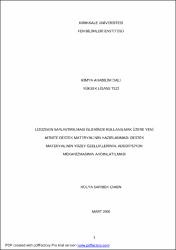| dc.contributor.advisor | Bayramoğlu, Gülay | |
| dc.contributor.author | Çimen, Hülya Sarıbek | |
| dc.date.accessioned | 2021-01-16T19:08:02Z | |
| dc.date.available | 2021-01-16T19:08:02Z | |
| dc.date.issued | 2006 | |
| dc.identifier.uri | | |
| dc.identifier.uri | https://hdl.handle.net/20.500.12587/16403 | |
| dc.description | YÖK Tez ID: 184288 | en_US |
| dc.description.abstract | ÖZETLİZOZİM SAFLAŞTIRILMASI İŞLEMİNDE KULLANILMAK ÜZERE YENİ AFFİNİTEDESTEK MATERYALİNİN HAZIRLANMASI: DESTEK MATERYALİNİN YÜZEYÖZELLİKLERİNİN, ADSORPSİYON MEKANİZMASININ AYDINLATILMASIÇİMEN, Hülya SarıbekKırıkkale ÜniversitesiFen Bilimleri EnstitüsüKimya Anabilim Dalı, Yüksek Lisans TeziDanışman: Doç. Dr. Gülay BAYRAMOĞLUMart 2006, 58 SAYFAAfinite kromatografisinde, biyospesifik ligandlar yerine, boyalar, amino asitler veşelatlanmış metal iyonları gibi pseudo-spesifik ligandlar kullanılmaktadır. Boya ligandlarınekonomik ve kararlı olmasının, kolaylıkla immobilize edilebilmelerinin ve proteinleriadsorplama kapasitelerinin yüksek olmasının, biyolojik ligandlara göre önemli avantajlarsağladığı bilinmektedir. Protein adsorpsiyonu yüzeyde bulunan fonksiyonel grupkompozisyonuna ve morfolojisine bağlı olduğundan, yüzey özelliklerindeki değişimin, yüzeyile çözülmüş madde arasındaki etkileşimin de değişmesine neden olduğu bilinmektedir.Protein adsorpsiyon mekanizmasının, sorbentin yüzey kimyasal yapısı, hidrofilisite ve proteinmoleküllünün sorbent yüzeyi ve birbiri ile elektrostatik etkileşimi, ayrıca protein molekülününyapısal kararlılığı gibi çok sayıda faktöre bağlı olduğu bilinmektedir.Çalışmamızda membran yapıda poli(hidroksietil metakrilat/kitosan) kompozit afinitemateryali UV fotopolimerizasyon yöntemi ile sentezlendi ve membran yüzeyine CibacronPDF created with pdfFactory Pro trial version www.pdffactory.comBlue F3GA boya ligandı kovalent olarak bağlandı. Boya-ligand bağlı afinite membranlarınkarekterizasyonu elemental analiz, FTIR spektroskopisi, taramalı elektron mikroskobu gibiteknikler kullanılarak yapıldı ve lizozim adsorpsiyonu çalışmalarında kullanıldı. Lizozimadsorpsiyonu çalışmasında farklı adsorpsiyon koşullarında termodinamik parametrelerbelirlendi ve adsorpsiyon ve desorpsiyon davranışları araştırıldı.Sulu ortamdan boya-ligand bağlı afinite membrana lizozim adsorpsiyonu değişenpH, sıcaklık, iyonik şiddet ve farklı başlangıç derişiminde çalışıldı. Boya-ligand bağlı afinitemembranların maksimum lizozim adsorpsiyon kapasitesi, kinetiği ve adsorpsiyon izotermmodeli yapılan bu adsorpsiyon çalışmaları ile belirlendi. Ayrıştırma ve saflaştırmaişlemlerinde lizozim enziminin aktivitesi, substrat olarak Micrococcus lysodeikticus bakterisikullanılarak belirlendi. Yumurta akından lizozimin ayrıştırılması ve saflaştırılması işlemiYBSK ile takip edildi.Anahtar Kelimeler: Membran, kinetik, termodinamik parametre, boya ligand,kromatografi, adsorpsiyon, lizozimPDF created with pdfFactory Pro trial version www.pdffactory.com | en_US |
| dc.description.abstract | ABSTRACTPREPARETION OF AFFINITY SUPPORT FOR SEPARATION OF LYSOZYME:CHARACTERIZATION OF SURFACE PROPERTIES AND ADSORPTIONMECHANISMÇİMEN, Hülya SarıbekKırıkkale UniversityGraduate School of Natural and Applied SciencesDeparment of Chemistry, M. Sc. ThesisSupervisor : Doç. Dr. Gülay BAYRAMOĞLUMart 2006, 58 pagesIn the affinity chromatography, pseudo-specific ligands, e.g., dyes, amino acidsand chelated metal ions have been used instead of biospecific ligands. Dyes is to someadvantages according to biological ligands in terms of economy, ease of immobilization,ligand stability and adsorbent capacity. The change in surface properties was found to affectthe interaction of surface with the surroundings. In particular, protein adsorption depends onthe surface composition and morphology of the membrane. There are many reports thatadsorption of proteins on the polymer membrane surface are quantitatively changed,depending on the type of ligands immobilised. The adsorption of protein is a very complexprocess, which can be determined by several factors. Among these, the chemical structure,surface roughness, the degree of hydrophilicity of surface, electrostatic interactions of thePDF created with pdfFactory Pro trial version www.pdffactory.comprotein molecules with each other and with surface, and the structural stability of proteinmolecules are the most important.In this research, poly(hydroxyethyle methacrylate/chitosan) composite affinitymembrane was synthesized by UV initiated photopolymerization and a dye ligand (i.e.,Cibacron Blue F3GA) was covalently immobilized onto membrane. Dye-ligand attachedaffinity membranes were characterized by FTIR, elemental analysis, contact angle andscanning electron microscopy.Lysozyme adsorption onto dye-lagand attached affinity membrane from aqueoussolutions containing different amounts of lysozyme at various pH, temperature and ionicstrength was investigated by continuous monitoring of the adsorption system. The maximumlysozyme adsorption capasities of the affinity membrane, kinetic and adsorption isothermmodel were determined from these adsorption studies. Separation and purification weremonitored by determining the lysozyme activity using Micrococcus lysodeikticus as substrate.Purification and separation of lysozyme from egg white were followed by YBSK.Key Words: Membrane, kinetic, thermodynamic parameters, dye ligand,chromatography, adsorption, lysozymePDF created with pdfFactory Pro trial version www.pdffactory.com | en_US |
| dc.language.iso | tur | en_US |
| dc.publisher | Kırıkkale Üniversitesi | en_US |
| dc.rights | info:eu-repo/semantics/openAccess | en_US |
| dc.subject | Kimya | en_US |
| dc.subject | Chemistry | en_US |
| dc.title | Yeni afinite destek materyalinin hazırlanması: Destek materyalinin yüzey özelliklerinin , adsorpsiyon mekanizmasının aydınlatılması | en_US |
| dc.title.alternative | Preparation of affinity support for seperation of lysozym: Characterization of surface properties and adsorption mechanism | en_US |
| dc.type | masterThesis | en_US |
| dc.contributor.department | KKÜ, Fen Bilimleri Enstitüsü, Kimya Anabilim Dalı | en_US |
| dc.identifier.startpage | 1 | en_US |
| dc.identifier.endpage | 68 | en_US |
| dc.relation.publicationcategory | Tez | en_US |
















